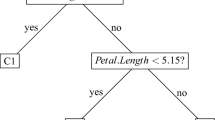Abstract
The standard Weights of Evidence (WE) model produces probability estimates for the presence of binary events. However, in many empirical studies the discrete event of interest can take on ordered values. For instance, the presence of mineral deposits may be classified further into different grades. In this paper, a new Ordered Weights of Evidence (OWE) model will be developed. Borrowing the conceptual framework of the latent variable interpretation of the standard Ordered Logistic Regression (OLR) model, the OWE can produce probability estimates for the presence of ordered discrete events. It will be shown that the OWE is computationally less intensive than the OLR. Through a simulation study, it will be shown that the OWE is comparable to the OLR both in terms of in-sample fit and out-of-sample forecasts.

Similar content being viewed by others
References
Agterberg, F. P., 1992, Combining indicator patterns in weights of evidence modelling for resource evaluation: Nonrenew. Resour., v. 1, no. 1, p. 35–50.
Agterberg, F. P., and Bonham-Carter, G. F., 1999, Logistic regression and weights of evidence modelling in mineral exploration, in Computer Applications in the Mineral Industries: Golden, CO, p. 483–490.
Agterberg, F. P., and Bonham-Carter, G. F., 2005, Measuring the performance of mineral-potential maps: Nat. Resour. Res., v. 14, no. 1, p. 1–17.
Agterberg, F. P., Bonham-Carter, G. F., and Wright, D. F., 1990, Statistical pattern integration for mineral exploration, in Gaál, G., and Merriam, D. F., eds., Computer Applications in Resource Exploration Prediction and Assessment for Metals and Petroleum: Oxford, Pergamon, p. 1–21.
Agterberg, F. P., Bonham-Carter, G. F., Wright, D. F., and Cheng, Q., 1993, Weights of evidence modelling and weighted logistic regression for mineral potential mapping, in Davis, J. C., and Herzfeld, U. C., eds., Computers in Geology, 25 Years of Progress: Oxford University Press, New York, NY, p. 13–32.
Bonham-Carter, G. F., 1994, Geographic information systems for geoscientists: Oxford, Pergamon, 398 p.
Bonham-Carter, G. F., Agterberg, F. P., and Wright, D. F., 1988, Integration of geological datasets for gold exploration in Nova Scotia, Photogram: Remote Sens., v. 54, no. 11, p. 1585–1592.
Bonham-Carter, G. F., Agterberg, F. P., and Wright, D. F., 1989, Weights of evidence modelling: a new approach to mapping mineral potential, in Agterberg, F. P., and Bonham-Carter, G. F., eds., Statistical Applications in the Earth Sciences: Geological Survey, Canada Paper 9-9, p. 171–183.
Deng, M., 2009, A conditional dependence adjusted weights of evidence model: Nat. Resour. Res., v. 18, no. 4, p. 249–258.
Emelyanova, I. V., Donald, G. E., Miron, D. J., Henry, D. A., and Garner, M. G., 2008, Probabilistic modelling of cattle farm distribution in Australia: Environm. Model. Assess., v. 14, p. 449–465.
Hansen, D. T., 2000, Describing GIS applications: spatial statistics and weights of evidence extension to arcview in the analysis of the distribution of archeology sites in the landscape, in Proceedings of the 20th Annual ESRI International User Conference, San Diego, CA.
Hansen, D. T., West, J., Simpson, B., and Welch, P., 2002, Modeling Spatial Uncertainty in Analysis of Archeological Site Distribution, in Proceedings of the 22nd Annual ESRI International User Conference, San Diego, CA.
Harris, D. P., Zurcher, L., Stanley, M., Marlow, J., and Pan, G., 2003, A comparative analysis of favorability mappings by weights of evidence, probabilistic neural networks, discriminant analysis, and logistic regression: Nat. Resour. Res., v. 12, no. 4, p. 241–255.
Johnston, J., and Dinardo, J., 1997, Econometric methods, (4th ed.): New York, McGraw-Hill, 531 p.
Raines, G. L., 1999, Evaluation of weights of evidence to predict epithermal-gold deposits in the great basin of the western United States: Nat. Resour. Res., v. 8, no. 4, p. 257–276.
Wooldridge, J. M., 2002, Econometric analysis of cross section and panel data: MIT Press, Cambridge, MA, 752 p.
Zavoina, R., and McElvey, W., 1975, A statistical model for the analysis of ordinal level dependent variables: J. Math. Sociol., v. 2, p. 103–120.
Author information
Authors and Affiliations
Corresponding author
Rights and permissions
About this article
Cite this article
Deng, M. An Ordered Weights of Evidence Model for Ordered Discrete Variables. Nat Resour Res 19, 83–89 (2010). https://doi.org/10.1007/s11053-010-9117-x
Received:
Accepted:
Published:
Issue Date:
DOI: https://doi.org/10.1007/s11053-010-9117-x




